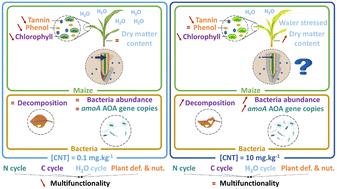当前位置:
X-MOL 学术
›
Environ. Sci.: Nano
›
论文详情
Our official English website, www.x-mol.net, welcomes your feedback! (Note: you will need to create a separate account there.)
Carbon nanotubes alter agrosystem multifunctionality
Environmental Science: Nano ( IF 5.8 ) Pub Date : 2024-06-20 , DOI: 10.1039/d4en00195h Mathieu Leroy 1, 2 , Vincent E. J. Jassey 1 , Jérôme Silvestre 1 , Maialen Barret 1 , Emmanuel Flahaut 2 , Camille Larue 1
Environmental Science: Nano ( IF 5.8 ) Pub Date : 2024-06-20 , DOI: 10.1039/d4en00195h Mathieu Leroy 1, 2 , Vincent E. J. Jassey 1 , Jérôme Silvestre 1 , Maialen Barret 1 , Emmanuel Flahaut 2 , Camille Larue 1
Affiliation

|
Since the discovery of the potential of carbon nanotubes (CNTs) in agriculture to improve crop yield, many studies have been conducted to understand which effects CNTs could have on agrosystem components. However, to date, very little is known about their impacts on ecosystem functions such as biogeochemical cycles or primary production and consequently on the multifunctionality of agrosystems. In this study, we aimed at understanding the impact of CNTs in microcosms including soil bacteria and a crop plant (maize) with a special focus on H2O, C and N cycles as well as crop nutrition and resistance. After a 6-week exposure, bacterial concentration was increased by 82% in soils exposed to 10 mg kg−1; in parallel, the organic matter decomposition rate was also significantly enhanced. An increase of nitrifier abundance was quantified with archaeal amoA gene copy numbers reaching +144% in soils exposed to 10 mg kg−1 of CNTs. Maize exposed to 0.1 mg kg−1 of CNTs had in average 34%, 18% and 12% lower chlorophyll, tannin and phenolic compounds, respectively but no impact was detected on the biomass production. Maize plants were water-stressed after exposure to 10 mg kg−1 of CNTs with a significant 17% increase of the dry matter compared to unexposed maize. CNT exposure also led to a significant decrease of H2O flux in the system. As a result, the multifunctionality of the agrosystem was significantly decreased at 0.1 mg kg−1. Structural equation modeling suggested that CNT impact on bacteria population in general, and on bacteria implied in denitrification and CO2 emission were the main factors influencing the multifunctionality index.
中文翻译:

碳纳米管改变农业系统的多功能性
自从发现碳纳米管(CNT)在农业中提高作物产量的潜力以来,已经进行了许多研究来了解碳纳米管对农业系统组成部分可能产生的影响。然而,迄今为止,人们对它们对生物地球化学循环或初级生产等生态系统功能以及由此对农业系统多功能性的影响知之甚少。在这项研究中,我们旨在了解碳纳米管对包括土壤细菌和农作物(玉米)在内的微观世界的影响,特别关注 H 2 O、C 和 N 循环以及作物营养和抗性。暴露6周后,暴露于10 mg·kg −1 的土壤中细菌浓度增加82%;同时,有机物分解率也显着提高。在暴露于 10 mg kg −1 CNT 的土壤中,古细菌 amoA 基因拷贝数达到 +144%,硝化菌丰度的增加被量化。玉米暴露于 0.1 mg kg −1 CNT 后,叶绿素、单宁和酚类化合物平均分别降低了 34%、18% 和 12%,但未检测到对生物量生产的影响。玉米植株在暴露于 10 mg kg −1 CNT 后受到水分胁迫,与未暴露的玉米相比,干物质显着增加了 17%。 CNT 暴露还导致系统中 H 2 O 通量显着降低。结果,农业系统的多功能性在0.1 mg kg −1 时显着降低。结构方程模型表明,CNT对总体细菌种群的影响以及对反硝化和CO 2 排放中隐含的细菌的影响是影响多功能指数的主要因素。
更新日期:2024-06-20
中文翻译:

碳纳米管改变农业系统的多功能性
自从发现碳纳米管(CNT)在农业中提高作物产量的潜力以来,已经进行了许多研究来了解碳纳米管对农业系统组成部分可能产生的影响。然而,迄今为止,人们对它们对生物地球化学循环或初级生产等生态系统功能以及由此对农业系统多功能性的影响知之甚少。在这项研究中,我们旨在了解碳纳米管对包括土壤细菌和农作物(玉米)在内的微观世界的影响,特别关注 H 2 O、C 和 N 循环以及作物营养和抗性。暴露6周后,暴露于10 mg·kg −1 的土壤中细菌浓度增加82%;同时,有机物分解率也显着提高。在暴露于 10 mg kg −1 CNT 的土壤中,古细菌 amoA 基因拷贝数达到 +144%,硝化菌丰度的增加被量化。玉米暴露于 0.1 mg kg −1 CNT 后,叶绿素、单宁和酚类化合物平均分别降低了 34%、18% 和 12%,但未检测到对生物量生产的影响。玉米植株在暴露于 10 mg kg −1 CNT 后受到水分胁迫,与未暴露的玉米相比,干物质显着增加了 17%。 CNT 暴露还导致系统中 H 2 O 通量显着降低。结果,农业系统的多功能性在0.1 mg kg −1 时显着降低。结构方程模型表明,CNT对总体细菌种群的影响以及对反硝化和CO 2 排放中隐含的细菌的影响是影响多功能指数的主要因素。






































 京公网安备 11010802027423号
京公网安备 11010802027423号